|

|

|

|

|
|

|
|
Thursday,
May 22, 2008
 Stimulus
or Pork?
- The
president of Northern Arizona University joined his counterparts at UA
and ASU in proposing a massive building plan at the three state
universities. Well, can we ever expect anything different?
No. But, the absurdity of this proposal lies in how it was
marketed - as a "fiscal stimulus" to help stave off the ill
effects of an economic recession. Ouch! I think I was
reasonably successful at convincing my compatriots on the editorial
board of the Arizona Daily Sun that it was a smokescreen, and penned
this comment, which ran
on
March 30. Stimulus
or Pork?
- The
president of Northern Arizona University joined his counterparts at UA
and ASU in proposing a massive building plan at the three state
universities. Well, can we ever expect anything different?
No. But, the absurdity of this proposal lies in how it was
marketed - as a "fiscal stimulus" to help stave off the ill
effects of an economic recession. Ouch! I think I was
reasonably successful at convincing my compatriots on the editorial
board of the Arizona Daily Sun that it was a smokescreen, and penned
this comment, which ran
on
March 30.
|
 Editorial
Board Sounding: NAU building plan too late for stimulus Editorial
Board Sounding: NAU building plan too late for stimulus
If it
looks like pork, smells like pork, and waddles like pork,
it’s probably not really “economic stimulus.” And,
so it goes for the recently floated proposal for $300 million
in building projects at NAU. Yes, this spending will
boost the fortunes of the local economy. But, this
isn’t some kind of salve for a slowing national economy –
it’s too small and it is ill-timed.
The idea
that government spending can boost the economy relies on the
existence of excess saving, meaning that purchasing power
exists and isn’t being used. If this is true, then it
is possible that these funds can be accessed through
government bonds and used to stimulate production and income.
But, timing is everything here.
Economic
downturns are generally short-lived. Embarking on a
spending spree in 2009, 2010 and 2011 is likely to be
counterproductive. That is, this government spending
will likely have to compete with private investment spending,
squeezing out residential and commercial development.
That is why the Fed is cutting interest rates now and why the
Congress has decided to send us tax rebates later this spring.
And, don’t think even this is without cost. If
inflation is surging a year from now, we’ll be pining for
the good old days of the sub-prime crisis!
It may be
that sound public policy determines that it is worthwhile to
build a one hundred million dollar health professions building
at NAU. Trying to sell that proposition based on its
“economic stimulus” effect leads me to be suspect.
Dennis
Foster has a Ph.D. in economics, teaches at the university
level and is an avid Grand Canyon hiker. |
With a
state budget that is verging on being $2 billion in the hole, the
prospect for cuts at NAU, and the other universities, has increased
dramatically in the weeks since this editorial was publish. It
seems that the "fiscal stimulus" notion has met a quick and
deserving death.
|
|

|
|
Thursday,
May 22, 2008
 Let
the Mountain Line Die
- The
Daily Sun editorial on this topic was quite favorable, in no small
part because it seems like the price is right! Well, so it
goes. Every couple of years we are asked to raise our taxes by
some miniscule amount to pay for some new project and it is awfully
hard to get people worked up about it. So, I thought I would
continue using Barack Obama-isms in this editorial, but I can't say
that my appeal to the "audacity of hope" really resonated
with readers. This comment ran
on
April 6. Let
the Mountain Line Die
- The
Daily Sun editorial on this topic was quite favorable, in no small
part because it seems like the price is right! Well, so it
goes. Every couple of years we are asked to raise our taxes by
some miniscule amount to pay for some new project and it is awfully
hard to get people worked up about it. So, I thought I would
continue using Barack Obama-isms in this editorial, but I can't say
that my appeal to the "audacity of hope" really resonated
with readers. This comment ran
on
April 6.
|
 Editorial
Board Sounding: Just say no to
feeding the transit leviathan Editorial
Board Sounding: Just say no to
feeding the transit leviathan
With five
Mountain Line ballot propositions up for a vote I am suffering
from an “audacity of hope.” Might Flagstaff voters
take this opportunity to rearrange the transit landscape?
I hope so.
Face it,
the Mountain Line is a failure. Here’s a statistic you
probably haven’t heard – one. As best I can tell,
that’s the number of passengers carried on the bus per mile
traveled. And, this number was forecast to fall to .66
by 2009! Doesn’t that make driving my SUV the
“earth-friendly” option?
Also, even
though the Feds paid for buses, and the Mountain Line only
needs to pay to operate the system, passenger fares only
account for 15% of what they spend. The tax subsidy per
regular rider appears to be between $1000 and $1500 per year!
If voters
rejected all five propositions would it cause hardships?
Well, not necessarily. We have bus stops all over town.
Why not open up this market to all who wish to compete?
Anyone with a bus (and a license) can ply the existing routes
and pick up passengers and charge any fare they want. I
would anticipate that service frequency, service coverage and
passenger levels would increase, while bus sizes and transit
times would fall.
If you
don’t like competition, then why not just give regular
riders a car? Maybe one of those new NANOs they make in
India (www.tatamotors.com)
that sell for $2500. We’d still save money!
Don’t Phoenix Flagstaff and just say no to feeding the
transit leviathan.
Dennis Foster has a Ph.D. in
economics, teaches at the university level, is an avid Grand
Canyon hiker and relied on data in the Flagstaff Five-Year
Transit Plan for this commentary. |
While some
transit propositions failed in the last election, one notion kicked
around was that there wasn't any political group championing its
cause. Well, that was not the case this time around, with a
group formed to raise money to post up signs around town extolling
voters to approve these propositions. The theme of these signs
is to "let the mountain line thrive," hence the title of my blog.
One problem that is well illustrated by this issue is that most people
think that the market would never provide mass transit service.
That is only true because of restrictions and regulations. And,
at a subsidy of more than the cost of taking a taxi, on a per person,
per mile traveled basis, certainly no market participants would come
up with the same kind of system that the government has.
This commentary got a lot of feedback - plenty of web comments, and
follow-up letters to the editor. Mostly, they just reinforce the
entitlement notion - taxpayers should pay for them to use this costly
mode of transport. The bus system director also wrote a
commentary, and while he noted that sometimes buses are full, didn't
provide any updated values to the number of passengers carried per bus
mile traveled.
All five propositions
passed by a wide margin. So it goes.
|
|

|
|
Wednesday,
May 28, 2008
 Criteria
for Entitlements
- The
topic of government support for this project, or that project, seems
to mostly center around two questions: Is it a good idea? Does
it cost much? This kind of thinking drives me crazy and I took
the opportunity of this editorial to lay out the bigger
questions: Who is entitled? Who isn't? Why?
The questions are not rhetorical. I really do want to know the
answers to these questions and I wish politicians were held
accountable to answer them. Far too often you get some kind of
mushy response that some proposal "helps the community"
which just avoids to spell out the specifics. This comment ran
on
April 13. Criteria
for Entitlements
- The
topic of government support for this project, or that project, seems
to mostly center around two questions: Is it a good idea? Does
it cost much? This kind of thinking drives me crazy and I took
the opportunity of this editorial to lay out the bigger
questions: Who is entitled? Who isn't? Why?
The questions are not rhetorical. I really do want to know the
answers to these questions and I wish politicians were held
accountable to answer them. Far too often you get some kind of
mushy response that some proposal "helps the community"
which just avoids to spell out the specifics. This comment ran
on
April 13.
|
 Ed.
Bd. Sounding: Candidates should be
challenged on government entitlements Ed.
Bd. Sounding: Candidates should be
challenged on government entitlements
With city
elections right around the corner, I want to support
candidates that will promise change I can believe in -
especially changing the way that government is used to promote
special interests, which concentrate benefits into few hands
while spreading costs around to many pockets.
In the
private market, this isn’t a problem, since these special
interests must convince people to voluntarily give up money to
support their causes – like the United Way, Habitat for
Humanity, the Flagstaff Symphony Orchestra, the Sunshine
Rescue Mission, the National Rifle Association, and the Nature
Conservancy to name but a few.
But, in
the public sector, the pursuit of special interests degrades
our freedoms and liberty by mandating that we pay for these
interests, be it a bridge to nowhere in Alaska, the inclusion
of “affordable housing” in residential developments, or
that taxpayers subsidize a small group of people who ride the
bus or an even smaller group that want to fly to Los Angeles.
Especially
appalling is how often recipients of these special benefits
feel entitled to what they have received rather than thankful
and humble! If you’re not sure on this score, re-read
the e-mail
commentaries, published in this paper last week, on
finding housing in Flagstaff.
So, in the
upcoming election for mayor and city council, I would ask
candidates to answer these simple questions, and to do so
honestly:
1.
What housing, jobs, and transportation are residents of
Flagstaff entitled to?
2. Who is entitled, and who isn’t?
3. Why?
Dennis Foster has a Ph.D. in
economics, teaches at the university level, is an avid Grand
Canyon hiker and once worked for Al White cleaning hotel rooms
for a living. |
The attitude that I see exhibited in
the public arena really is one of entitlement. One letter
writer, critical of my opposition to the bus, referred to how he had
decided to retire to Flagstaff from St. Louis. And, he feels
entitled to a bus system, subsidized by taxpayers. In the
housing stories was a recurring theme - people moving to Flagstaff,
finding it difficult to make ends meet, and being "forced" to move
elsewhere.
If the city is to promote "affordable housing" who is going
to be helped? Will it be long time residents? Or,
residents in some favored job category (police, nurse or
teacher)? And, why is that? This is the problem with
government welfare - all taxpayers must pay to help those deemed
suitable. I am much more comfortable with discrimination
practiced by charitable groups that raise their money through
voluntary contributions. For more on this topic, read
the story profiling two families and their housing woes, as well
as the web comments posted below the story.
In my bio I mention Al White, who is a current city council member and
often champions the "need" for higher wages and affordable
housing. The point being that even I had jobs that are bottom of
the barrel.
|
|

|
|
Wednesday,
May 28, 2008
 All
Aglow Over Mining
- There
has been a surge in companies filing documents to do exploratory
drilling on the Colorado Plateau in search of uranium deposits.
Some of these sites are a bit south of the Grand Canyon, and this has
opened up a barrage of opposition. I had been planning on
showing the film Mine
Your Own Business to my students for some time now, and had
arranged to use the campus library auditorium for this purpose.
So, my commentary on this subject allowed me to also advertise this
film. Mostly, the auditorium was filled with my students, who
were favorably disposed to the idea that environmentalists go too far,
although there were others in the audience from the public, including
some folks from one of the mining companies. This comment ran
on
April 20. All
Aglow Over Mining
- There
has been a surge in companies filing documents to do exploratory
drilling on the Colorado Plateau in search of uranium deposits.
Some of these sites are a bit south of the Grand Canyon, and this has
opened up a barrage of opposition. I had been planning on
showing the film Mine
Your Own Business to my students for some time now, and had
arranged to use the campus library auditorium for this purpose.
So, my commentary on this subject allowed me to also advertise this
film. Mostly, the auditorium was filled with my students, who
were favorably disposed to the idea that environmentalists go too far,
although there were others in the audience from the public, including
some folks from one of the mining companies. This comment ran
on
April 20.
|
 Edit.
Board Sounding: Memo to uranium opponents: 'Mine' your
own business Edit.
Board Sounding: Memo to uranium opponents: 'Mine' your
own business
What good
is mining? To those who care to notice, it is a more
significant contributor to our standard of living than is our
ability to hunt and gather. Without mining, you can’t
ride around in subsidized buses, you can’t heat your
affordable home, you can't operate your solar oven, and you
can’t enjoy your favorite microbrew.
Should
uranium mining be banned in northern Arizona? Some argue
it should, because it was poorly done in the past and that it
poses some risk. But, then, why not ban all production?
There is no such thing as a world without risks. Let’s
assess these risks, and assess the benefits. Then,
let’s have an open, and honest, discussion about uranium
mining. Maybe it shouldn’t be allowed, but maybe it
should.
Indeed, if
you believe all the mumbo jumbo about human caused global
warming dooming our planet to a fiery grave, you should be an
unabashed supporter of uranium mining – the benefits of
saving the human race must certainly outweigh mining’s risk
factors. Stop being bitter, clutching at your solar
panels and your copy of “The Population Bomb.” Grab
a shovel and help move us into a truly nuclear age.
The clash
between environmentalists and people struggling for a decent
living in mining is going on all around the globe. If
that clash interests you, come see a special screening of the
documentary, “Mine Your Own Business” at NAU’s Cline
Library Auditorium on Wednesday, April 23 at 7 p.m. Free
and open to the public.
Dennis Foster has a Ph.D. in
economics, teaches at the university level, and is an avid Grand
Canyon hiker. |
Once again I was able to include an Obama-ism
in my editorial - the snippet about "bitter, clutching"
comes from his faux pas in San Francisco about middle America.
Also, the reference to the solar oven is courtesy of Lisa Rayner,
local activist, who was profiled on the front page of the paper that
week, next to her solar oven.
|
|

|
|
Monday,
June 9, 2008
 STS-124
Launch
- The
space shuttle program is winding to an end - only 10 more missions
(after STS-124) are left before
the fleet is retired. For years I have been meaning to go down
to Florida and see a launch. But, with the program on a regular
schedule I always put that off. Now, with the impending end
of the shuttle program, it was finally time to get going on
this! Eric was quite enthusiastic about going, so together we
headed out of Flagstaff in the early morning of Friday, May 30,
arriving at out hotel in Cocoa Beach, Florida, in the early evening,
the day before the launch of STS-124. Shuttle missions are often
postponed, so we booked a room for five nights and kept our fingers
crossed that any delay would fall within our "launch
window." STS-124
Launch
- The
space shuttle program is winding to an end - only 10 more missions
(after STS-124) are left before
the fleet is retired. For years I have been meaning to go down
to Florida and see a launch. But, with the program on a regular
schedule I always put that off. Now, with the impending end
of the shuttle program, it was finally time to get going on
this! Eric was quite enthusiastic about going, so together we
headed out of Flagstaff in the early morning of Friday, May 30,
arriving at out hotel in Cocoa Beach, Florida, in the early evening,
the day before the launch of STS-124. Shuttle missions are often
postponed, so we booked a room for five nights and kept our fingers
crossed that any delay would fall within our "launch
window."
We headed up to the Kennedy Space Center (KSC) Saturday morning.
Only those who had pre-purchased tickets are let in on launch
day. Our tickets, and a parking pass, were sent to me about ten
days before our trip. Since the launch was slated for late in
the day - at 5 p.m. - we had a lot of time to see the place. We
started with a bus tour of the center. These tours only ran
until 11 a.m. and we were one one of the last ones. We didn't
get to make the stop at the observation gantry because of the launch,
but did stop at the Saturn V building and, from the lawn outside, we
could see across the 3.5 miles to the launch pads. Some
bleachers were set up nearby, and this is were NASA VIPs come to see
the launch.
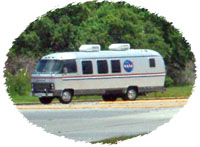 We caught one of the last buses back to the visitors center, and en
route, we got to see the astronauts passing by in their famous little
trailer (photo to the right). Traffic was stopped for their
passage to the launch pad. Once back at the visitors center, we
checked out a couple of exhibits (the Shuttle Launch Experience is
cool) and set up our chairs in the viewing area next to the Rocket
Garden. The place was filling up. There was a large screen
showing the video from NASA TV and some ongoing commentary from a
stage set up below the screen. At just past 5 p.m., with all
going well, the shuttle launched, with the Japanese Kibo
module in its payload bay. Quite exciting, to be sure.
The shuttle clears the trees in front of us before we hear it, as it
shot straight up into the sky. The most remarkable thing to me
was how bright the exhaust flames were - it was like looking at a fire
in the sky. On TV, the brightness just washes out to white and
you don't get the same effect as we did. Our view only lasted a
couple of minutes, as the shuttle disappeared behind its own exhaust
trail. Eric watched through his new binoculars and could see the
separation of the solid rocket boosters. Below is a video I took
of the launch, which is posted up on YouTube - my premier
posting. OK, so now I need to learn some editing skills.
All in due time.
We caught one of the last buses back to the visitors center, and en
route, we got to see the astronauts passing by in their famous little
trailer (photo to the right). Traffic was stopped for their
passage to the launch pad. Once back at the visitors center, we
checked out a couple of exhibits (the Shuttle Launch Experience is
cool) and set up our chairs in the viewing area next to the Rocket
Garden. The place was filling up. There was a large screen
showing the video from NASA TV and some ongoing commentary from a
stage set up below the screen. At just past 5 p.m., with all
going well, the shuttle launched, with the Japanese Kibo
module in its payload bay. Quite exciting, to be sure.
The shuttle clears the trees in front of us before we hear it, as it
shot straight up into the sky. The most remarkable thing to me
was how bright the exhaust flames were - it was like looking at a fire
in the sky. On TV, the brightness just washes out to white and
you don't get the same effect as we did. Our view only lasted a
couple of minutes, as the shuttle disappeared behind its own exhaust
trail. Eric watched through his new binoculars and could see the
separation of the solid rocket boosters. Below is a video I took
of the launch, which is posted up on YouTube - my premier
posting. OK, so now I need to learn some editing skills.
All in due time.
Following the launch, we had "dinner with an
astronaut." Not personally, although there aren't more than
a couple of hundred people for this event. Our featured
astronaut was retired pilot Jon
McBride, who flew the Challenger for STS-41G
in 1984. He was a fascinating speaker and related well to the
crowd. Afterwards, he took pictures with each of us, as you can
see below. One piece of information that I was not aware of -
the "space shuttle" is the designation for the whole launch
vehicle, including the rockets/fuel tanks. What we call the
shuttle (Discovery, in this case) is technically called the
"orbiter." So, we saw the space shuttle launch of the
Discovery orbiter.
Since
the shuttle launch went off without a hitch, we decided to spend a day
at the beach. Cocoa Beach is famous, of course, for its
proximity to the launch facilities, and its use in the old I
Dream of Jeannie TV show. Since this is the off season for
the beach - temps in the low 90s - there was plenty of room to hang
out. We walked about a mile down the beach to the Cocoa Beach
Pier, where we ate lunch and saw a pelican wandering around.
Nice leisurely day and whenever we were back at the room, we had NASA
TV tuned on, to catch all the space action!
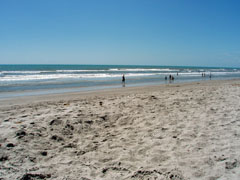 |
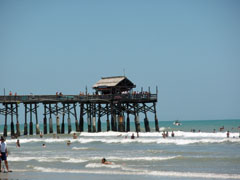 |
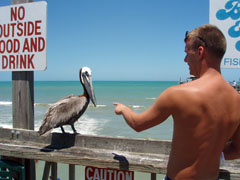 |
| Cocoa
Beach. |
The
pier at Cocoa Beach. |
Don't
tease the pelicans! |
Our Kennedy Space Center admission tickets allowed for a second visit
within seven days. Since we didn't see everything on launch day,
we decided to go back on Monday and spend another day there. The
night before, we bumped into some guys from Phoenix, who had been at
our table for "dinner with an astronaut." They
recommended the "NASA Up Close" tour, so that's what we
opted for as soon as we arrived at KSC.
In stark contrast to launch day, the crowd on this day was quite
small. They say that they get about a million visitors a year -
I'd bet that half of those are here on launch days, which means that
usually this is a rather laid back place to visit. The bus tour
was great. We went out on the causeway, where public viewing of
the launch is allowed, but quite difficult to get (tickets are snapped
up right away for that venue). We also drove right up and around
the two launch pads - 39A and 39B. Cool, cool, cool. We
stopped at a viewing area halfway between the two launch pads, which
was quite a sight.
The tour dropped us off back at the Saturn V building, where we could
pick up the regular tour to return to the visitors center. Since
Eric and I had missed the stop at the International Space Station (ISS)
building on the launch day tour (it was too late), we took the
opportunity of going there. The public area overlooks the main
floor here, where space station components are being readied for later
flights. We saw the "cupola"
on the work floor.
Once back at the visitors center, we decided to do the Shuttle Launch
Experience again (it is a cool simulation) and we saw the two 3-D Imax
movies. They were great. It was another full day.
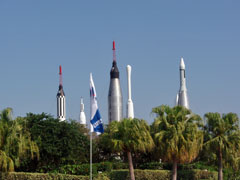 |
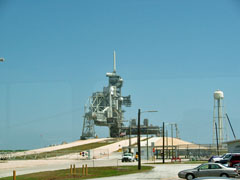 |
 |
| The
Rocket Garden at KSC. |
Launch
pad 39B. |
The
famed Vehicle Assembly Bldg. |
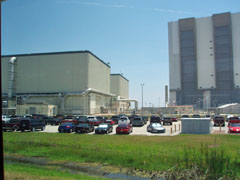 |
 |
 |
| Shuttle
garages next to the VAB. |
Cupola
slated for delivery to ISS. |
Exhibit
of testing models at IMAX. |
There was one more day of our trip,
and we decided to spend it, again, at the beach. I rented an
umbrella, since I got some sunburn on our previous visit. Eric
had a boogie board that he used on the small waves here, while I
enjoyed a day of reading and soaking up the views. We saw some
dolphins breaching the water offshore and pelicans flying overhead,
periodically diving into the water in search of food.
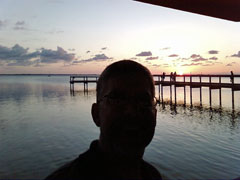 |
 |
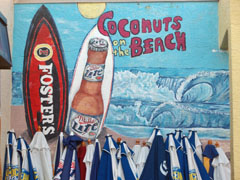 |
| Sunset
over the Banana River. |
Our
rental shade for the day. |
Mural
at Coconuts on the Beach. |
Wednesday morning (June 4) we traveled back to Orlando to fly
home. It was a great trip and chance to see the shuttle launch,
as well as enjoy the beach and eat seafood all the time - the gator
bites were good at
Florida's
Seafood Bar & Grill, the crayfish and shrimp chowder was
fabulous at Coconuts
on the Beach, the rock shrimp was a treat at the
Old
Fish House, and the lobster bisque was great at Jack
Baker's Lobster Shanty.
|
|

|
|
Wednesday,
June 11, 2008
 Sounding
Board Editorials
- Although I haven't yet posted up the final five editorials, I
have created a
space
where all of the editorials I wrote for the Arizona Daily Sun during
the spring of 2008 can be found. Enjoy. Sounding
Board Editorials
- Although I haven't yet posted up the final five editorials, I
have created a
space
where all of the editorials I wrote for the Arizona Daily Sun during
the spring of 2008 can be found. Enjoy.

|
|

|
|
Wednesday,
June 25, 2008
 Taxes
and Morality
- When
the issue of sales taxes comes up in the local arena, I am constantly
amazed at how easy it is for supporters to make the argument that we
should support such a tax, or its expansion, in part because visitors
pay a sizable chunk of these taxes. Well, it happens everywhere,
but that doesn't make it right. How often have you traveled
somewhere and, upon inspecting your hotel room bill seen a line item
called "room tax?" It is the same principle - tax
people who are just passing through and make them help to pay for
local services which they aren't going to use! It is the
ultimate in taxation without representation. And, yet, it enjoys
such widespread political support. I have never heard anyone
raise the issue of the morality of such a taxing scheme. While
we are constantly barraged with issues of ethical behavior, how can
such a lapse go so totally unnoticed? The ballot measure to
raise taxes to help fund the bus system has been touted as a sort of
kinder and gentler tax since it is a sales tax and we get a lot of
visitors in Flagstaff, who really are never going to use the bus
system. So, it's like free money. I decided to address the
issue with this editorial. This comment ran
on
April 27. Taxes
and Morality
- When
the issue of sales taxes comes up in the local arena, I am constantly
amazed at how easy it is for supporters to make the argument that we
should support such a tax, or its expansion, in part because visitors
pay a sizable chunk of these taxes. Well, it happens everywhere,
but that doesn't make it right. How often have you traveled
somewhere and, upon inspecting your hotel room bill seen a line item
called "room tax?" It is the same principle - tax
people who are just passing through and make them help to pay for
local services which they aren't going to use! It is the
ultimate in taxation without representation. And, yet, it enjoys
such widespread political support. I have never heard anyone
raise the issue of the morality of such a taxing scheme. While
we are constantly barraged with issues of ethical behavior, how can
such a lapse go so totally unnoticed? The ballot measure to
raise taxes to help fund the bus system has been touted as a sort of
kinder and gentler tax since it is a sales tax and we get a lot of
visitors in Flagstaff, who really are never going to use the bus
system. So, it's like free money. I decided to address the
issue with this editorial. This comment ran
on
April 27.
|
 Edit.
Board Sounding - Taxes,
morality and ethics: Voting 'no' only choice left Edit.
Board Sounding - Taxes,
morality and ethics: Voting 'no' only choice left
Taxes
represent the seizure of your wealth and income, which is used
to fund various governmental services. While there is a basic
immorality to forcing our compliance, it is ethical to have a
basic structure of government in order to protect individual
freedoms. What isn't ethical is to expand and grow government,
extending the reach of its coercive power, just because some
argue that it "makes sense." Most people believe
that the ends don't justify the means. So, for example, even
if you believe that particular residents should have access to
a bus system, it doesn't justify forcing taxpayers to pay for
this system. It is the hallmark of the lazy social activist
that individual freedoms can be so easily trumped by
government force.
Indeed, one particularly contemptible argument made in favor
of these taxes is that visitors will end up paying a
substantial share of these monies. Can we possibly think of a
more undemocratic process? To vote for taxes on others that
cannot vote has got to be not only unethical, but absolutely
immoral.
Two years ago, city voters rejected an attempt to make the
sales tax and transit tax permanent, and rejected an increase
in the transit tax. Despite that, the operating budget for the
city has risen from $80 million to $100 million. It seems that
the only check we have on insatiable, unsustainable and
unethical local government spending is to vote down pretty
much any tax proposal that requires our consent.
Dennis Foster has a Ph.D. in
economics, teaches at the university level, and is an avid Grand
Canyon hiker. |
My comment
about "making sense" was a retort to a letter published in the paper
criticizing my earlier stance on the bus system. The author of
that letter, Marcus Ford, and I have tangled in print over the years
and will likely continue to do so.
|
|

|
|
Thursday,
June 26, 2008
 Natural
Quiet - For
some years now, there has been wrangling over the concept of
"natural quiet" at the Grand Canyon. Of course, it
doesn't mean quiet. Rather, it means the absence of man-made
noise, which is, apparently, quite offensive to some people. The
problem really starts with measurement, and whether people actually
notice the noise itself! The editorial
in the paper mostly contended that this was all a shell game, and
probably just politically driven. Yes, that's probably
true. Still, it is a step in a more reasonable direction, so I
applauded this move. I have previously
blogged
on this topic, when there was a scoping session held in town on
this issue a couple of years ago. This comment
ran on
May 4. Natural
Quiet - For
some years now, there has been wrangling over the concept of
"natural quiet" at the Grand Canyon. Of course, it
doesn't mean quiet. Rather, it means the absence of man-made
noise, which is, apparently, quite offensive to some people. The
problem really starts with measurement, and whether people actually
notice the noise itself! The editorial
in the paper mostly contended that this was all a shell game, and
probably just politically driven. Yes, that's probably
true. Still, it is a step in a more reasonable direction, so I
applauded this move. I have previously
blogged
on this topic, when there was a scoping session held in town on
this issue a couple of years ago. This comment
ran on
May 4.
|
 Edit.
Board Sounding - Put
a price on 'natural quiet' air routes with auctions Edit.
Board Sounding - Put
a price on 'natural quiet' air routes with auctions
The Park
Service, to their credit, wants to exclude high flying jets
from being included in the convoluted measurement of
“natural quiet” at the Grand Canyon. But, there is a
better way.
First,
let’s dispense with the notion that “natural quiet” has
any objective meaning. It doesn’t. When I’m
hiking, I can’t hear much over my panting, groaning and
moaning, except for maybe my pack creaking. Totally
unnatural, except to me! And, Park Service helicopters
are certainly the most egregious violators of quiet at the
canyon, and I haven’t heard that they’ll be curtailed.
So,
let’s cut to the chase. Rather than debating on
Byzantine regulations to restrict overflights, let’s use the
market to find an efficient solution.
Here’s
how. Identify as many overflight routes as is practical
over the Grand Canyon and auction off the rights to these
routes. They can be purchased by individuals, or by
activist groups, or by air tour operators. Then, instead
of using the political process to determine what is best (and,
probably getting it wrong), this auction will insure that the
resource goes to its highest valued use, be it for quiet or
for air tours. And, the money from the auction could be
used to improve the park, to the benefit of all visitors.
If you
don’t like that idea, I suppose we could just have hikers
download a “natural quiet” recording of the Grand Canyon
onto their MP3 players. Then, they can enjoy the natural
quiet as much as they want!
Dennis Foster has a Ph.D. in
economics, teaches at the university level, and is an avid Grand
Canyon hiker. |
As it turned out, Cara Lynn and I went hiking
down the Tanner trail this very weekend, so I could cache an
inflatable kayak for a bigger
hike the following week. She spent many hours atop the
Redwall, overlooking the river and a big chunk of the eastern part of
the canyon, while I continued down to find a spot to leave the
kayak. She noted that it was often perfectly quiet, and she
wouldn't have noticed that except for the occasional passing plane
every 30 minutes or so. Hmm... interesting point - if it wasn't
for the noise, you wouldn't notice the quiet. Still, I think it
is a silly argument. There are no overflights at night, nor are
there any river trips plying their way down the Colorado. So, at
the beginning and end of each day, while one is puttering around in
camp, it is quiet! And, it is appreciated!
|
|

|

|

|

|
|

|